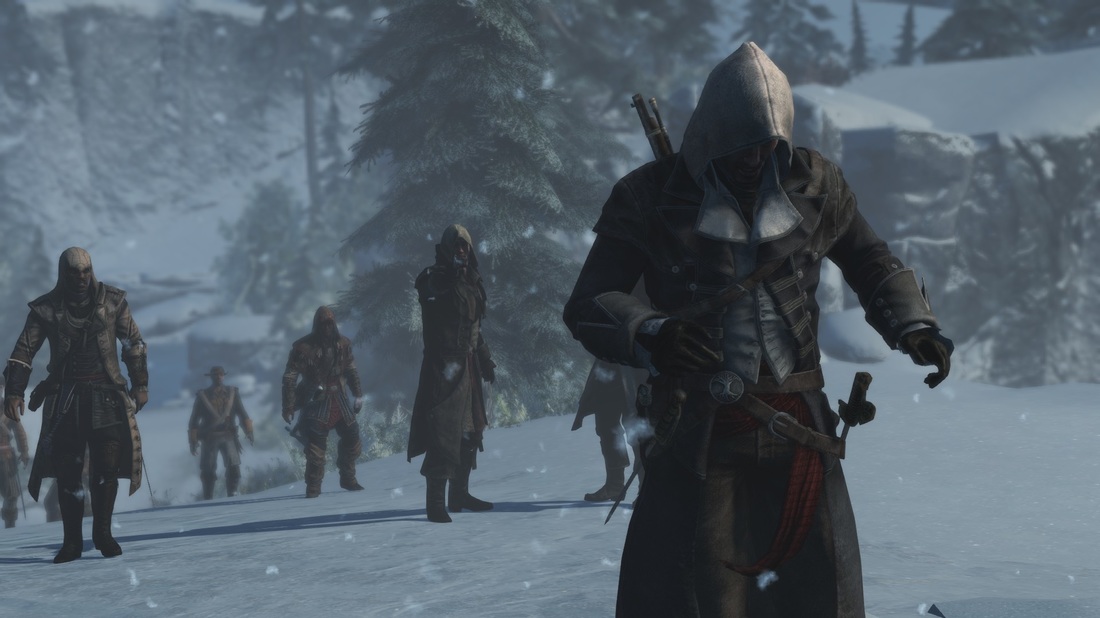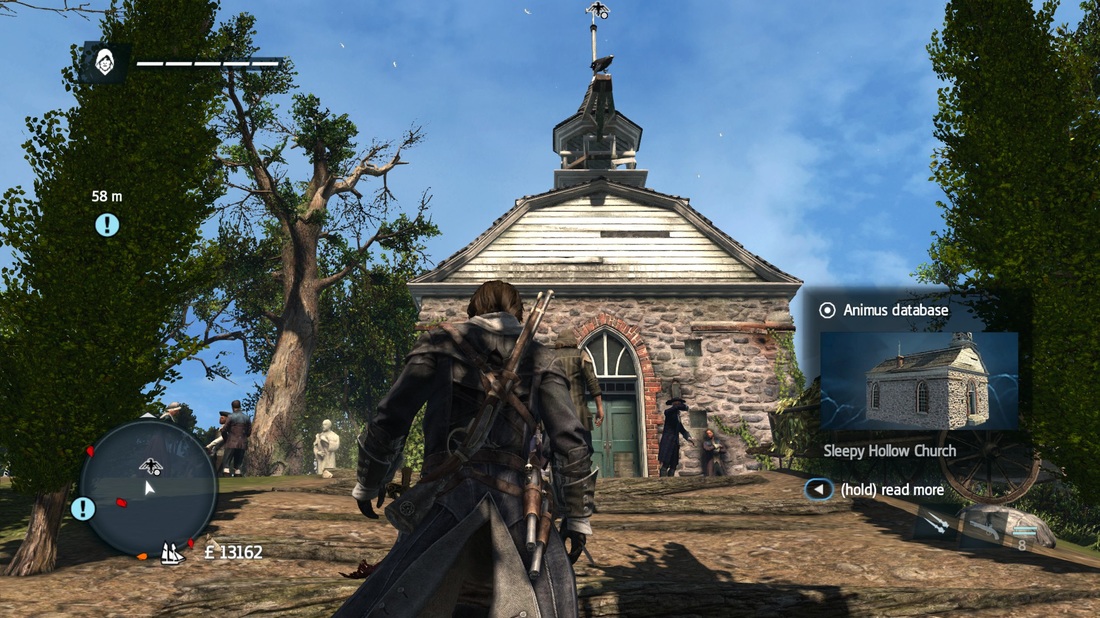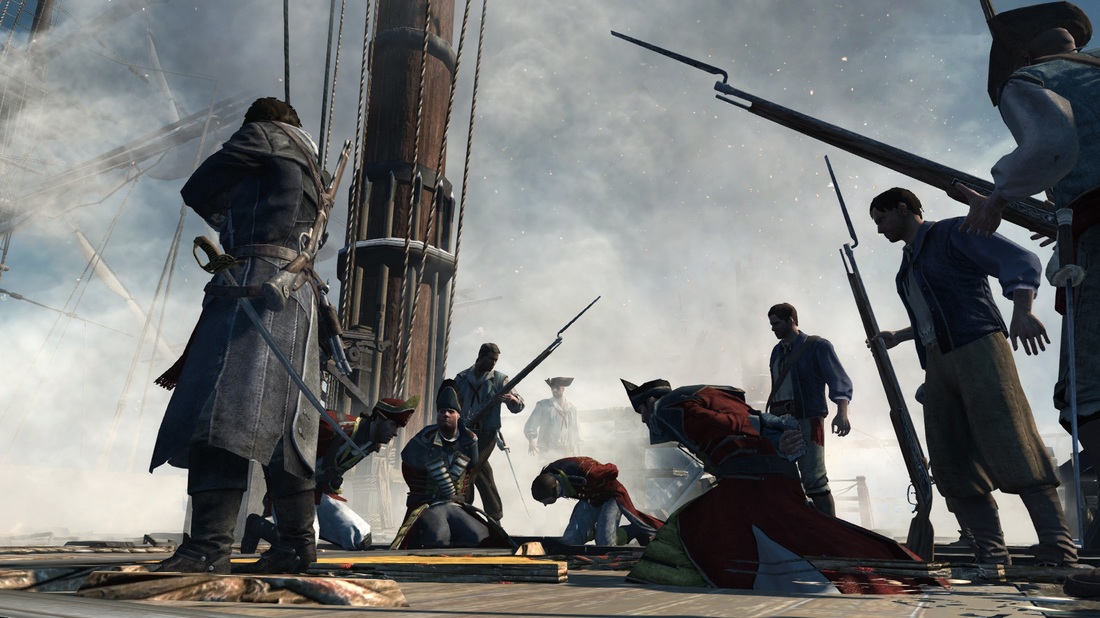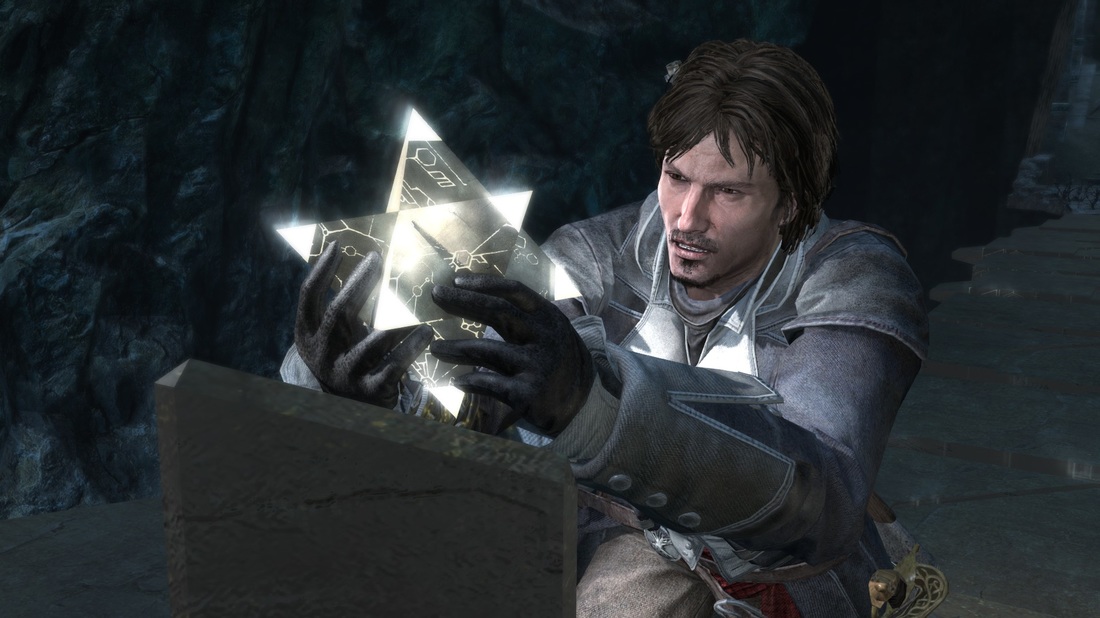 The other side of a very strange coin. The other side of a very strange coin.
After Shay inadvertently causes a massive earthquake in Lisbon, he tries to keep the assassins from attempting to find more Pieces of Eden. When they refuse to give up their search and attempt to murder Shay, he is rescued by the Templars and joins their ranks. It is up to Shay to prevent more disasters and try to get the Assassins to see the error in their ways.
1. Gameplay
I am now one of the few people I know to have played both of the new Assassin’s Creed games. Unity and Rogue are two very different titles with very different experiences. Their primary focuses are diametrically opposed. Unity was about large-scale urban exploration with an emphasis on art and visual beauty. Rogue is about ship-based piracy and small scale land operations with an emphasis on gameplay and characters. Both have their merits, but Rogue comes across as far more memorable than Unity.
In Rogue you play as Shay Patrick Cormac, an assassin who is eventually forced to join the Templars to protect himself and humanity. It explores the Templar’s viewpoint of the world and their conflict with the Assassins. The game, the characters, and the missions communicate a vision of what happens if freedom is taken to an extreme. While the ideas of extreme order turning into tyranny have been explored in numerous Assassin’s Creed games, Rogue explores the idea of extreme freedom turning into anarchy. The Assassins have become no better than organized criminals, reveling in their lawlessness and using it to terrorize the civilians around them.
The player works to stop this, but not in a way that felt like he was fully indoctrinated into the Templar’s orders and ideals. Shay’s ideals, communicated through the dialog and his actions, are always to protect humanity and work towards the betterment of mankind. The only thing that changes is his view of how this peace is obtained.
It’s a great premise, and one that gives me hope for future titles being less about strict enforcement of tyranny or anarchy and more about the conflicts that arise as a result of political and policy disagreements between the Assassins and Templars. It’s an interesting idea that, if well written, could be a lot of fun to explore.
Mechanically, this game plays like a sequel to Assassin’s Creed 4: Black Flag. It takes many of the elements from Black Flag and improves greatly on the, placing the character in new situations and gives the player new equipment to work through. The assassins were never extremely intelligent when I fought against them, but they did surprise me on numerous occasions. They would occasionally try to assassinate me from rooftops or jump out at me from the bushes. While I thought it was far too easy to see them, it did change the way that I approached certain missions and objectives.
I really enjoyed this game, much more than I enjoyed Unity. Both were good, but this gave a breadth of gameplay that Unity never really attempted. Unity’s mechanics seemed designed to artificially inflate gameplay time. Rogue never felt that way.
I completed this game in around 18 hours. This includes every main campaign mission and a good portion of the side quests and activities. While I never completed every mission in this game, I felt like I managed to get my fill of everything interesting.
That being said, there were plenty of other little things I could go back and do. There were a good number of collectibles I never obtained, a few locations I never explored fully, and some achievements I could have completed. It would likely take me around 12 more hours to complete 100% of this game.
Despite the fact that this is shorter than many of the other Assassin’s Creed games, it felt like a good length. I hardly ever felt like the game length was unfairly inflated (unlike in Unity), and so I walk away from this game feeling good about my overall experience.
While the movement mechanics in this game have significantly improved when compared to previous titles in the franchise, there were still a number of times when I was unable to climb up things that seemed simple to climb, or hit invisible walls on objects I should have easily vaulted over. These would often become plainly evident when I was scrambling to avoid detection or to outrun an enemy.
While the movement from my ship to land and back again wasn’t necessarily frustrating, it often felt like it took far too long to accomplish, something that significantly deterred me from leaving my ship without an obvious dock. This may have been because it broke with the normally fast, fluid gameplay and movement mechanics. While the problems with the movement that I mentioned in the first paragraph of this section were definitely more frustrating, this issue come up more commonly.
2. Parental Notices
Violence is the most prominent major element in this game by far. The player will use a variety of weapons to shoot, stab, slice, poison, and hang enemies. Despite all of this, gore is never present in the game.
That being said, plenty of the slashing attacks can get pretty brutal, especially if the player uses a large sword. Normal attacks will cause a small amount of blood from enemies, but all bladed weapons will be used to slash and impale enemies in some fairly gross ways. It’s not necessarily what the player directly sees in these attacks, since there is no gore in the game, but it’s the raw power behind Shay’s attacks and how obviously devastating they can be to enemies.
While bladed weapons will be the most prominent means of killing enemies, that is by no means the only way for the player to kill enemies. Guns can be used as well. Hits from all firearms will result in a small amount of blood and, usually, a dead enemy.
The player can also use grenades and other explosives. Explosions cause enemies to fly into the air, but do not cause any sort of blood or gore.
The player has access to some poisoned weapons as well. These include a poisoned dart rifle and poisoned grenades. The player can either use a sleeping gas to knock out enemies or a “berserk” gas to cause enemies to go into a rage and attack anyone nearby. I ended up using the berserk darts and gas liberally throughout my gameplay, since it would significantly reduce the enemy count while allowing me to remain stealthy.
Sexuality is not a factor in this game.
A number of characters throughout the world can be seen drinking. However, the main character only drinks if the player goes to a tavern for information. The action is quick and there are no positive or negative effects from drinking (other than obtaining information from the tavern barkeep).
The player can also “liberate” tobacco from captured enemy ships. The player can only sell this to gain money.
The same games from Assassin’s Creed: Black Flag once again appear in Rogue. Checkers, 9 Man Morris, and one or two others are playable and the player can bet on whether or not he will win the match. However, I found these games to be stupidly difficult and a totally unreliable source of income. When my character is making tens of thousands of gold every twenty minutes, the five hundred I could potentially win after an hour of frustrating gameplay seems meaningless.
3. Other Factors
There are no modding tools available in this game.
Where in the past religion was a prominent factor in the Assassin’s Creed games, it’s almost completely absent from Rogue. There are still churches scattered throughout the landscape, but any discussion of God or religion is basically nonexistent.
While much of this game’s conflict revolves around international politics and warfare, and while the player does work to establish and entrench the rule of the British in the Northeast, the player will constantly fight against and kill the local law enforcement, especially when that involves the French. Any local authorities, including the British, can and will be killed by the player. Sometimes it’s done to get supplies, sometimes it’s done to accomplish an objective, and sometimes it’s done just because they’re in the way. But the player will spill a lot of French and British blood in this game.
Piracy also remains a prominent element throughout the entirety of this game. The player can bombard and seize ships of all sizes. Doing this rewards the player with valuable cargo that can be used to purchase upgrades in the game, so there is a serious motivation for the player to constantly engage in piracy.
There are no multiplayer modes in this game.
As with all Assassin’s Creed games, parkour and freerunning elements remain a prominent factor in every moment of this game. Whether it’s climbing quickly up the walls of tall buildings or holding onto a weighted rope in order to ascend a hundred feet up a ship’s mast, the player will engage in extreme and physically taxing activities in every moment of this game.
And the way this game is set up makes it all look so easy. Shay is able to sprint indefinitely, climb up dozens of feet in a single leap from a dead stop, and quickly use a few wooden walls and boards to ascend three full stories. It’s incredible, and incredibly dangerous.
Magical elements are rare, but present in this game’s story. The Assassins are hunting for “Pieces of Eden”, magical devices of immense power. What they are inadvertently discovering and mistaking for Pieces of Eden, though, actually hold up the structure of the Earth. When disturbed, these structures collapse and cause devastating earthquakes. These are the most obvious forms of magic in the game by far.
There are no additional factors in this game.
3 Comments
Austin Perot
8/8/2015 05:21:43 am
Will you be doing a review of the new Assassin's Creed?
Reply
Carmine
8/8/2015 06:49:10 am
That is definitely the plan!
Reply
Grant
10/7/2015 06:54:14 pm
Can u do one of just cause 2 please Leave a Reply. |
Like what we do? Want to see more? Donate to the site using the button below!
Not sure what a term means? Read the definitions!
Not sure what a review section is about? Find out more information!
|
















 RSS Feed
RSS Feed